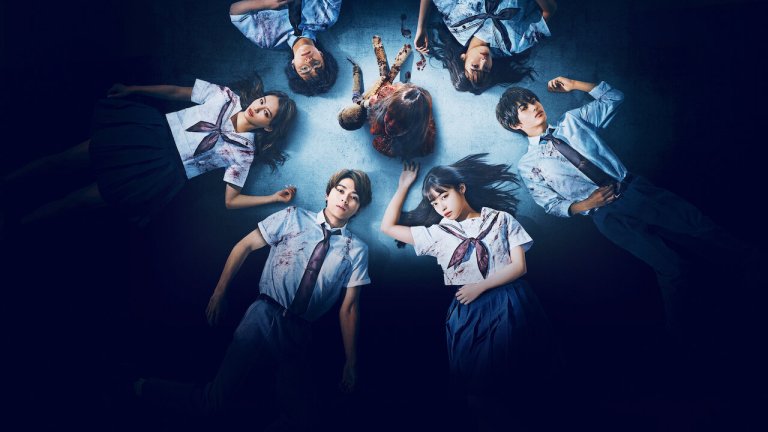Netflix’s Re/Member Is a Time Loop to Forget
Netflix's Re/Member combines time loops, ghosts, and many friendship-building montages.

This article contains spoilers for Re/Member.
Nothing says Japanese horror films like supernatural scares, urban legends, and grudge-bearing spirits. Eiichirō Hasumi, director of Assassination Classroom and Resident Evil: Infinite Darkness, attempts to bring all these elements together in Re/Member, a movie adaptation of Karadasagashi (Body Search), a manga spread over 17 volumes and 153 chapters.
The plot of Re/Member follows the age-old movie formula of time loops with its core theme leaning towards puzzle-solving. Japanese cinema is no stranger to playing with time, The Girl Who Leapt Through Time being the most well-known of the bunch, though this film takes on a far darker approach to the genre. In case you haven’t read the manga, six classmates are haunted by an unforgiving spirit and tasked with the retrieval of its body parts. Fail to find those parts and the day resets, bringing about your untimely and brutal death.
While the concept of Re/Member is definitely an interesting one, the movie falls short in its character development and lack of story depth. We spend far too much time seeing our characters get torn apart and only ever seem to delve into their personalities on a fairly surface level. It also seems like the film bounces around from being a brutal horror, to a puzzle-solving teen flick, and J-Drama. Regrettably, the end result would have benefited greatly if one of these styles was chosen as the main driver.
Still, it’s a perfectly acceptable film as long as you’re not expecting anything groundbreaking from the genre or story. Kanna Hashimoto who plays the lead role of Asuka Morisaki gives a stand-out performance and is certainly one to watch in the number of films she’s set to appear in this year (Yudo, Haru ni Chiru, Kingdom 3).
Over the film’s hour and a half runtime, we’re presented with a series of brutal deaths that don’t seem to make use of the time-loop genre as well as they should do. None of the classmates seem to learn anything each time they die, nor do they focus on the best course of action for properly evading the Yūrei. While there’s technically nothing to be done other than finding the body parts, it’s still not thought through well enough for this type of movie.
Learning, improving, and adapting, are all things that make the time-loop genre so interesting, but it seems to be somewhat of an afterthought in this case. It’s especially true when compared to something like Edge of Tomorrow, a time-loop film inspired by Hiroshi Sakurazaka’s light novel All You Need Is Kill.
However, it’s not nonstop action for the entire film, with more than one friendship-building montage where the classmates seem to forget about the dire situation they’ve found themselves in. A trip to the beach with a bizarre Baywatch-esque slow-motion scene and a lunchtime pitstop accompanied by upbeat J-Pop music take away from the severity of what’s going on and confuse identity within the J-Horror sector.
While these jovial moments, very common in J-Dramas, attempt to build our attachment to the characters, in this case it has the opposite effect. Such diversions are acceptable in J-Dramas because of the fairly light-hearted nature of the genre. Incorporating it into any form of J-Horror, though, severely takes away its credibility as a serious movie, even if it is supposed to be a teen flick. A clear example of this miscalculation is when the spirit of Miko Onoyama (The Red Person) has her fist through one of the student’s heads, and the next moment they’re laughing over a plate of kabocha korokke seemingly unphased by their predicament.
This, in itself, wouldn’t be a dealbreaker, but the introduction of the spirit’s second phase makes it a lot harder to forgive.
If escaping from a seemingly unstoppable girl with her favorite doll wasn’t hard enough, the next part appears to be near impossible. Add to that the issue of getting eaten will now entirely erase you from reality, and things seem grim for our classmates.
The problem here is that this predator-faced monster seems to lose a lot of what made it scary in the first place. Its first form was grounded in at least some amount of reality (or Japanese folklore in this case) and can be recognized by several references to ancient mythology. For instance, if a person dies either suddenly or violently (as Miko Onoyama did), their spirit (Reikon – 霊魂) turns into an Onryō, a ghost seeking vengeance. The Onryō will hang around until a ritual to properly lay it to rest is completed, which in this case means finding all the body parts.
The stereotypical long-haired, white face image of a spirit that’s so popular in Japanese horror is originally based on a drawing by Maruyama Ōkyo, and those same features of Yūrei (ghosts) were popularized by traditional theater such as Noh (能, Nō) and kabuki (歌舞 伎). A supernatural antagonist that lurks in the shadows which we are only given glimpses of or a spirit steeped in historic urban legends and Japanese folklore would have made for a much scarier villain than a giant and somewhat clumsy doll. Granted, the addition of getting eaten makes things far more complicated, but not scarier.
As previously discussed, unlike many time-loop films, Re/Member doesn’t spend too much time focusing on the actual day that repeats itself. The students spend most of that time planning where to look for the body parts and, to some degree, growing their friendship. Though the same day repeats over and over again, the only times we see the characters make use of their knowledge of how it plays out is to save a cat from being run over, and stop a plant pot from smashing. So while they’re forced to repeat this period, the only way they can spend their time is by speculating on the location of the missing limbs and hoping to find them at the stroke of midnight (a time when the bridge to the spirit world is at its thinnest) when they’re transported back to the school.
One of the most interesting parts of Re/Member is the reason each of these students was chosen to complete the ritual. In their own way, they were all suffering from loneliness, anxiety, or lack of social acceptance, all problems faced by teenagers their age. In order to beat the red person, they must work together and overcome both mental and physical challenges that eventually lead to each character conquering these personal issues. It would have been good to see this explored in a little more depth as it’s definitely one of the strongest aspects of the film, though it is unfortunately another area left relatively untouched.
Re/Member is available to stream on Netflix now.
